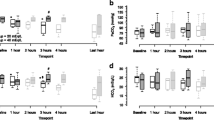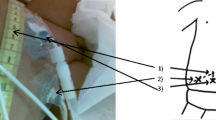Abstract
Objective
Conventional intermittent hemodialysis in the critically ill patient can be associated with hemodynamic and respiratory instability. Intermittent hemodialysis induced arterial hypotension might be detrimental. We therefore studied the influence of intermittent hemodialysis on systemic and regional oxygen transport in critically ill patients.
Design
Prospective descriptive study.
Setting
Medical/surgical 24-bed intensive care unit in a university hospital.
Patients
Eleven critically ill patients admitted to the intensive care unit (APACHE III score: 82±12) and developing multiple organ dysfunction syndrome with acute renal failure. All patients were mechanically ventilated and hemodynamically stable with inotropic support. Systemic oxygen transport variables were calculated, and arterial blood lactate concentration was measured before, during, and after intermittent hemodialysis. Tonometer PCO2 was measured using a tonometer, and arterial-tonometer CO2 gap was used as an indicator of intestinal intramucosal acidosis.
Results
Intermittent hemodialysis induced an increase in calculated systemic oxygen consumption (P<0.01). During intermittent hemodialysis there was a significantly higher need of inotropic support (P<0.05) to maintain arterial blood pressure, cardiac index, and calculated systemic arterial oxygen delivery. The arterial-tonometer CO2 gap increased significantly during and after the procedure.
Conclusion
In critically ill patients with multiple organ dysfunction syndrome intermittent hemodialysis induces an increase in oxygen consumption. Despite higher inotropic support to maintain systemic calculated oxygen delivery intestinal intramucosal acidosis occurs during intermittent hemodiallysis and may even persist after the procedure is terminated.
Similar content being viewed by others
References
Mythen MG, Webb AR (1994) The role of gut mucosal hypoperfusion in the pathogenesis of post-operative organ dysfunction. Intensivé Care Med 20: 203–209
Corwin HL, Bonventre JV (1985) Acute renal failure in the intensive care unit. II Intensive Care Med 14:86–96
Schetz M, Lauwers PM, Ferdinande P (1989) Extracorporeal treatment of acute renal failure in the intensive care unit: a critical view. Intensive Care Med 15:349–357
Fiddian-Green RG (1992) Tonometry: theory and applications. Intensive Care Med 9:60–65
Fiddian-Green RG, Pittenger G, Whitehouse WM Jr (1982) Back-diffusion of CO2 and its influence on the intramural pH in gastric mucosa. J Surg Res 33:39–48
Riddington D, Balasubramanian K, Clutton-Brock T, Bion J (1994) Measuring carbon dioxide tension in saline and alternative solutions: quantification of bias and precision in two blood gas analyzers. Crit Care Med 22: 96–100
Doglio GR, Pusajo JF, Egurrola MA, Bonfigli GC, Parra C, Vetere L, Hernandez MS, Fernandez S, Palizas F, Gutierrez G (1991) Gastric mucosal pH as a prognostic index of mortality in critically ill patients. Crit Care Med 19:1037–1040
Huyghebaert MF, Dhainaut JF, Monsallier JF, Sclemmer B (1985) Bicarbonate hemodialysis of patients with acute renal failure and severe sepsis. Crit Care Med 13:840–843
Mehta BR, Fischer D, Ahmad M, Dubose TD Jr (1983) Effects of acetate and bicarbonate hemodialysis on cardiac function in chronic dialysis patients. Kidney Int 24:782–787
Vincent JL, Vanherweghem J-L, Degaute J-P, Berré J, Dufaye P, Kahn RJ (1982) Acetate-induced myocardial depression during hemodialysis for acute renal failure. Kidney Int 22:653–657
Chen TS, Friedman HS, Smith AJ, Del Monte ML (1983) Hemodynamic changes during hemodialysis: role of dialyzate. Clin Nephrol 20:190–196
Henrich WL, Hunt JM, Nixon JV (1984) Increased ionized calcium and left ventricular contractility during hemodialysis. N Eng J Med 310:19–23
Bouffard Y, Viale JP, Annat G, Guillaume C, Percival C, Bertrand O, Motin J (1986) Pulmonary gas exchange during hemodialysis. Kidney Int 30: 920–923
Craddock PR, Fehr J, Brigham KL, Kronenberg RS, Jacob HS (1977) Complement and leukocyte-mediated pulmonary dysfunction in hemodialysis. N Engl J Med 296:769–774
Lonneman G, Bingel M, Floege J, Koch KM, Shaldon S, Dinarello CA (1988) Detection of endotoxin-like interleukin-1-inducing activity during in vitro dialysis. Kidney Int 33:29–35
Lonneman G, Koch KM, Shaldon S, Dinarella CA (1987) Induction of interleukin-1 (IL-1) from human monocytes adhering to hemodialysis (HD) membranes. Kidney Int 31:238
Lamy M, Thijs LG (1994) Round table conference on mediators of sepsis. Intensive Care Med 20:239–241
Schiffl H, Lang SM, König A, Strasser T, Haider MC, Held E (1994) Biocompatible membranes in acute renal failure: prospective case-controlled study. Lancet 344:570–572
Sigler MH, Teehan BP (1987) Solute transport in continuous hemodialysis: a new treatment for acute renal failure. Kidney Int 32:562–571
Author information
Authors and Affiliations
Additional information
deceased
Rights and permissions
About this article
Cite this article
Diltoer, M., Laureys, M., Huyghens, L. et al. Intermittent hemodialysis in critically ill patients with multiple organ dysfunction syndrome is associated with intestinal intramucosal acidosis. Intensive Care Med 22, 747–751 (1996). https://doi.org/10.1007/BF01709516
Received:
Accepted:
Issue Date:
DOI: https://doi.org/10.1007/BF01709516




